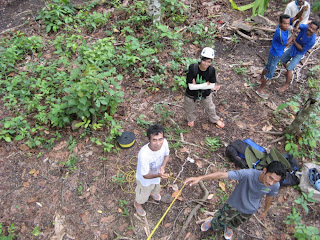Chimneys of the brick kilns
Arang batu means coal. Batu Arang is an old coal mining town in north Selangor. The coal mine was established around 1910. Mining stopped in the 1950's and the town lost its former glory. During The Emergency the town was a base for the communist anti-British forces.
Many of the Chinese miners still live here, but now the town is more multi-ethnic. In recent years the area was threatened by severe erosion due to dropping water tables as a result of the coal mining.
Today there is little sign of where the coal was mined. The mines are apparently now flooded and are under the lakes. However another industry here was brick making, and although this closed down around 2002, the chimneys of the brick kilns still exist.
See also
Batu Arang community hall and
Batu Arang blog.
---------
I've copied this page from New Straits Times as it is interesting, but no longer available on their www.
Sleepy Hollow With a Rich Mining Legacy
By Ranjeetha Pakiam
THE sleepy town of Batu Arang will be 100 years old in a few years. Looking at it today, it's hard to imagine it was once a thriving, rich coal mining town where thousands lived and worked, writes RANJEETHA PAKIAM.
During its heyday in the 1930s and 1940s, Batu Arang was a large bustling town, second only in size and population to Kuala Lumpur in Selangor.
The coal-rich town was prosperous - not many places could boast of an airport, a railway station and a relatively modern hospital at that time, but Batu Arang had all these and more.
Batu Arang, so named because of the treasure of arang batu, or coal, lying beneath the earth, was nicknamed "Small Golden Hill".
Coal was discovered around 1911, and entrepreneur J.A. Russell, who later started the Boh tea plantations in Cameron Highlands, set up Malayan Collieries in Batu Arang in 1913, transforming a large tract of jungle into a thriving industrial centre 40km outside Kuala Lumpur.
Shops were open all hours of the day and night. Tired coal miners finishing their shifts in the wee hours of the morning could look forward to proper meals in 24-hour restaurants.
Airplanes flew in to drop off the salaries of the huge workforce, and steam-engined trains chugged in and out of the railway station picking up the coal and transporting it to nearby Rawang and other major towns.
Beginning in 1915, the mines of Batu Arang produced 13.2 million tonnes of coal. Production was at its peak in 1940 - more than 2,000 tonnes were mined each day.
But the emergence of diesel as the main source of fuel in the late 1950s sounded the death knell for coal - and ultimately Batu Arang.
When the coal mines closed down in 1958, the miners, bricklayers and labourers left with their British bosses.
Buildings were torn down after they became unsafe because the ground, riddled with catacombs and mining passages, became unstable.
Batu Arang was not spared during the Emergency from 1948 to 1960. It was declared a "Black Area" during the long fight against the threat of communism and its people lived in fear.
Today, the old ventilation tunnels offer a glimpse of the old abandoned mines, but few are brave enough to venture into the darkness. Picturesque lakes dot the town, once the huge open cast mines which have filled with water over the years.
The town centre is just a roundabout with the police station, two rows of 1920s shophouses and several small restaurants around it.
People are beginning to trickle back to work in the factories in the area - most notably SME Ordnance Sdn Bhd which produces weapons and ammunition, and Kilang Tenaga Kimia Bhd - but it remains a shadow of what it once was.
Its rich history would have been lost to the younger generation living there if not for the efforts of a primary school teacher whose fascination with the town prompted him to conduct his own research.
Yaakob Razali, 34, was posted to Sekolah Kebangsaan Batu Arang in 1997.
The Kedah-born teacher says he loved the quiet lifestyle the town offered, yet he was intrigued by Batu Arang's place in history.
"There are so many historical remains scattered around the town which are really interesting.
"And some of the old-timers who I spoke to here had some really fascinating stories to tell," he said.
After spending two years compiling information, Yaakob decided to share what he had with the townspeople.
With the support of the headmistress Hasmah Ambak and his colleagues, Yaakob put on a week-long exhibition at the school from Sept 11 - 17.
(c) 2006 New Straits Times. Provided by ProQuest Information and Learning. All rights Reserved.
Source: New Straits Times
-----------------------------
© Liz Price
No reproduction without permission

































































